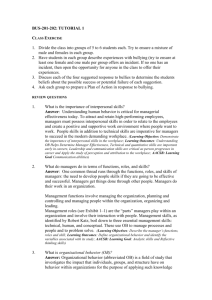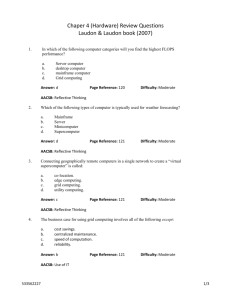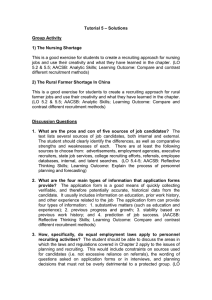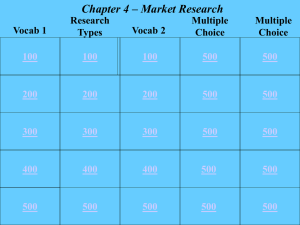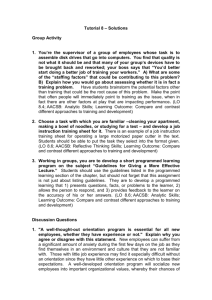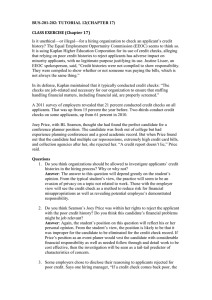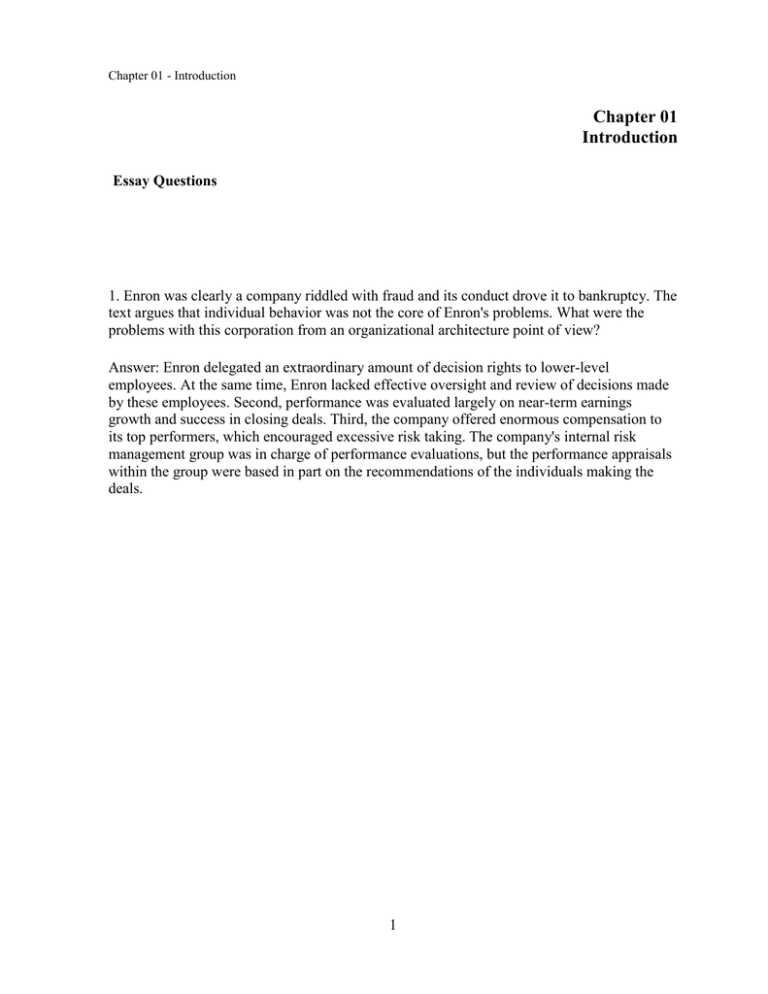
Chapter 01 - Introduction
Chapter 01
Introduction
Essay Questions
1. Enron was clearly a company riddled with fraud and its conduct drove it to bankruptcy. The
text argues that individual behavior was not the core of Enron's problems. What were the
problems with this corporation from an organizational architecture point of view?
Answer: Enron delegated an extraordinary amount of decision rights to lower-level
employees. At the same time, Enron lacked effective oversight and review of decisions made
by these employees. Second, performance was evaluated largely on near-term earnings
growth and success in closing deals. Third, the company offered enormous compensation to
its top performers, which encouraged excessive risk taking. The company's internal risk
management group was in charge of performance evaluations, but the performance appraisals
within the group were based in part on the recommendations of the individuals making the
deals.
1
Chapter 01 - Introduction
Difficulty: 02 Medium
Blooms: Understand
AACSB: Reflective Thinking
Topic: Introduction
2. What are the three critical aspects of corporate organization? Which of the three
components is most important for the success of a firm?
Answer: The three critical aspects of corporate organization are the assignment of decision
rights, the reward system, and the performance-evaluation system. The assignment of decision
rights is likely to be most important for the success of a firm.
Difficulty: 02 Medium
Blooms: Understand
AACSB: Reflective Thinking
Topic: Managerial Economics and Organizational Architecture
3. What are some of the ways in which risky borrowers cheated on housing loans?
Answer: Borrowers overstated their income and claimed "liar loans." Fraudulent borrowers
would recruit people to apply for more liar loans, provide unreliable home appraisals,
purchase homes at lower prices from the sellers, and pocket the difference.
Difficulty: 01 Easy
Blooms: Remember
AACSB: Reflective Thinking
Topic: Managerial Economics and Organizational Architecture
4. What was the main reason for "liar loans" to proliferate?
Answer: The incentives to mortgage brokers were such that the more loans they generated, the
greater was their compensation. Therefore, the mortgage brokers had no incentive to go
behind the scenes to check the viability of repayment.
Difficulty: 01 Easy
Blooms: Remember
AACSB: Reflective Thinking
Topic: Managerial Economics and Organizational Architecture
5. Is there a relationship between a CEO's retirement and the R&D expenses in a firm?
2
Chapter 01 - Introduction
Answer: There is. In many instances, a CEO reduces R&D expenses a few years before
retirement. This boosts earnings in these selected years. If the CEO's bonuses are linked to
earnings, then the CEO retires with a big package from reduced R&D, while the firm suffers
in the long run due to the failure of keeping up with innovation.
Difficulty: 02 Medium
Blooms: Understand
AACSB: Reflective Thinking
Topic: Managerial Economics and Organizational Architecture
6. DHL, a successful European company, is attempting to overcome various legal
problems in order to enter the U.S. market of overnight package delivery. Its two major
competitors would be FedEx and UPS. As DHL looks to set up a U.S. subsidiary, it wishes to
benchmark its organizational architecture. What should it do?
Answer: DHL should realize that a successful organizational architecture is more than a
collection of good ideas or good parts. A successful organization should be carefully
coordinated to align individuals' incentives with the firm's goals. DHL's organizational
architecture has survived in a European legal and regulatory environment. In contrast,
FedEx’s and UPS’s architectures have survived under the U.S. legal system in the market for
overnight delivery. There is no single "best" organizational form for all firms in all external
legal and market environments. Instead, the best organizational form for a firm depends
critically on its current business environment. DHL should be aware of possible unintended
side effects of changing one component of organizational architecture without considering its
effects on the other parts of organizational architecture.
Difficulty: 02 Medium
Blooms: Understand
AACSB: Reflective Thinking
Topic: Economic Darwinism
7. How can good management practices be useful in a global economy?
Answer: The example of Tianjin Optical & Electrical Communication Group in China and its
collaboration with Motorola comes to mind. Tianjin was a failing company. But, with the
adoption of U.S. telecommunications quality-control and management practices, it has
succeeded. Joint ventures such as these are likely to be useful if the foreign companies adopt
U.S. management tools in terms of supervision, control, and rewards.
Difficulty: 02 Medium
Blooms: Understand
AACSB: Reflective Thinking
3
Chapter 01 - Introduction
Topic: Purpose of the Book
8. Explain why the top executives of Société Générale are more likely to be blamed than
Jérôme Kerviel.
Answer: Kerviel had been playing the markets for over a year and several red flags were
ignored by the bank managers. The supervisors accepted Kerviel's trades without much
difficulty. The managers were ready to go along, as long as Kerviel was not making any
money for himself, and as long as his activities were creating some benefit for the system.
The managers had embraced a system of risk taking. It is their irresponsibility primarily that
behooved Kerviel to behave the way he did.
Difficulty: 03 Hard
Blooms: Analyze
AACSB: Analytic
Topic: Purpose of the Book
Multiple Choice Questions
9. Bloomberg Business sums up the failure of Enron to
A. September 11, 2001.
B. flawed organizational design.
C. too much debt.
D. risky projects in India and the oil price hikes.
Answer: B
Difficulty: 01 Easy
Blooms: Remember
AACSB: Reflective Thinking
Topic: Introduction
10. Identify a critical aspect of corporate organization.
A. the assignment of decision rights within a company
B. the cost structure of the firm
C. the pricing strategies of the rival firms
D. the capita to labor ratio
Answer: A
Difficulty: 01 Easy
Blooms: Remember
4
Chapter 01 - Introduction
AACSB: Reflective Thinking
Topic: Managerial Economics and Organizational Architecture
11. The authors argue that successful corporations assign decision rights in ways that
A. effectively link decision-making authority with good information.
B. structure moneymaking tools for all employees.
C. completely eliminate the potential for fraud.
D. rely on monitoring and evaluation for all creativity.
Answer: A
Difficulty: 01 Easy
Blooms: Remember
AACSB: Reflective Thinking
Topic: Managerial Economics and Organizational Architecture
5
Chapter 01 - Introduction
12. According to the text, successful firms tend to set up
A. an organizational architecture that is complex and decisions are "top-down."
B. an organizational architecture that is least expensive and decisions are "top-down."
C. an organizational architecture that links decision making with decision rights.
D. an organizational architecture that keeps decision rights reserved for the senior
management.
Answer: C
Difficulty: 01 Easy
Blooms: Remember
AACSB: Reflective Thinking
Topic: Managerial Economics and Organizational Architecture
13. The example of Enron shows that
A. selection of people is the key to organizational success or failure.
B. large incentives play an important role in motivating people within a corporation.
C. the success of a business is possible in a regulatory environment.
D. organizational structure is extremely important in business success.
Answer: D
Difficulty: 02 Medium
Blooms: Understand
AACSB: Reflective Thinking
Topic: Managerial Economics and Organizational Architecture
14. Economics provides a theory to explain
A. how a successful business can be started.
B. how managers can cheat and get away with it.
C. how people make choices.
D. how businesses compete in the market.
Answer: C
Difficulty: 01 Easy
Blooms: Remember
AACSB: Reflective Thinking
Topic: Managerial Economics and Organizational Architecture
15. Recent research on CEO behavior tells us that CEOs generally
A. increase their firm’s R&D expenditure so as to boost earnings long before they retire.
B. reduce their firm’s R&D expenditure so as to boost earnings long before they retire.
C. reduce their firm’s R&D expenditure so as to boost earnings just before they retire.
D. increase their firm's R&D expenditure so as to boost earnings just before they retire.
6
Chapter 01 - Introduction
Answer: C
Difficulty: 01 Easy
Blooms: Remember
AACSB: Reflective Thinking
Topic: Managerial Economics and Organizational Architecture
16. Which of the following is true of standard economic analysis?
A. It characterizes a firm as a black box that transforms inputs to outputs.
B. It focuses on the internal architecture of a firm.
C. It applies basic economic tools to examine the effects of managerial decisions.
D. It characterizes a firm as an organization that generates economic growth.
Answer: A
Difficulty: 01 Easy
Blooms: Remember
AACSB: Reflective Thinking
Topic: Managerial Economics and Organizational Architecture
17. "Subprime mortgages" refer to
A. interest rates that are over and above the prime rate to risky borrowers.
B. mortgages made to credit-worthy borrowers at low interest rates.
C. mortgages made to borrowers who do not usually qualify for loans.
D. mortgage brokers making huge commissions on volume.
Answer: C
Difficulty: 01 Easy
Blooms: Remember
AACSB: Reflective Thinking
Topic: Managerial Economics and Organizational Architecture
18. In the textbook, there is an example of a software firm in which the managers provided a
financial incentive to get rid of software bugs. The result was that software writers added
more bugs into the software. This example shows that
A. financial incentives should never be used.
B. most employees are corrupt.
C. incentives can create perverse effects.
D. high-tech firms are unique.
7
Chapter 01 - Introduction
Answer: C
Difficulty: 02 Medium
Blooms: Understand
AACSB: Reflective Thinking
Topic: Managerial Economics and Organizational Architecture
19. If the market demand and the market price for a product increase, then the reaction of
companies that manufacture this product
A. will be identical.
B. will be dependent on the prevailing tax system.
C. will depend on whether or not the organization is attuned to market incentives.
D. will be dependent on the government regulatory mission.
Answer: C
Difficulty: 02 Medium
Blooms: Understand
AACSB: Reflective Thinking
Topic: Managerial Economics and Organizational Architecture
20. Economic Darwinism is seen when
A. organizational architecture is optimized by employing new technology.
B. competition weeds out ill-designed organizations that fail to adapt.
C. corporate mutations occur, like Enron.
D. market benchmarks are employed.
Answer: B
Difficulty: 01 Easy
Blooms: Remember
AACSB: Reflective Thinking
Topic: Economic Darwinism
21. Which of the following is a benefit of a competitive market structure?
A. efficient decision making
B. a low tax rate
C. high cost of production
D. high market power
Answer: A
Difficulty: 02 Medium
Blooms: Understand
AACSB: Reflective Thinking
Topic: Economic Darwinism
8
Chapter 01 - Introduction
22. Fama and Jensen suggest that "the form of organization that survives in an activity is the
one that delivers the product demanded by customers at the lowest price while covering
costs." This is an example of
A. market and organizational efficiency.
B. market and organizational equity.
C. economic benchmarking.
D. defective organizational architecture.
Answer: A
Difficulty: 02 Medium
Blooms: Understand
AACSB: Reflective Thinking
Topic: Economic Darwinism
23. In order to survive in a market, a firm needs to
A. make extensive use of available technology.
B. hire more capital and less labor.
C. produce a product demanded by consumers at the lowest possible price while covering
costs.
D. charge higher prices for its products than its rivals and revise prices upward periodically.
Answer: A
Difficulty: 02 Medium
Blooms: Understand
AACSB: Reflective Thinking Topic: Economic Darwinism
24. The term Darwinism is important because it indicates
A. the randomness of existing companies.
B. that the surviving companies are the best in the absolute sense.
C. the capability to transform as the external environment changes.
D. the existence of a higher intelligence that promotes success.
Answer: C
Difficulty: 02 Medium
Blooms: Understand
AACSB: Reflective Thinking
9
Chapter 01 - Introduction
Topic: Economic Darwinism
25. The principle “survival of the fittest” tells us that
A. only the most innovative and adaptive firms are likely to survive competition.
B. only the most innovative and adaptive firms are likely to attract more competition.
C. only the least innovative and adaptive firms are likely to survive competition.
D. only the most innovative and adaptive firms are likely to migrate to other products.
Answer: A
Difficulty: 01 Easy
Blooms: Remember
AACSB: Reflective Thinking
Topic: Economic Darwinism
26. The business practice of looking for a firm that has best practices in an area and then
emulating those practices is called
A. organizational architecture.
B. benchmarking.
C. competitive markets.
D. decision management.
Answer: B
Difficulty: 01 Easy
Blooms: Remember
AACSB: Reflective Thinking
Topic: Economic Darwinism
27. Benchmarking means
A. blind copying from others.
B. copying from the best so as to become better.
C. looking at yourself and telling others what to do.
D. looking at yourself and telling yourself you are the greatest.
Answer: B
10
Chapter 01 - Introduction
Difficulty: 01 Easy
Blooms: Remember
AACSB: Reflective Thinking
Topic: Economic Darwinism
28. Benchmarking may be a problem if
A. the current architecture is relatively unstable and proposed changes add huge benefits.
B. the current architecture is relatively stable and proposed changes add huge benefits.
C. the current architecture is relatively unstable and proposed changes add little benefits.
D. the current architecture is relatively stable and proposed changes add little benefits.
Answer: D
Difficulty: 02 Medium
Blooms: Understand
AACSB: Reflective Thinking
Topic: Economic Darwinism
29. If the technology, the nature of competition, or the regulatory environment change in an
industry, then
A. the appropriate organizational architecture will change too.
B. a good organizational architecture will shut down.
C. the organizational architecture will be able to restore the former market environment.
D. the industry will increase production.
Answer: A
Difficulty: 02 Medium
Blooms: Understand
AACSB: Reflective Thinking
Topic: Economic Darwinism
30. From Jerome Kerviel's actions in Société Générale, we realize that in a business
organization, managers may turn a blind eye to certain "red flags" in the system if
A. the managers themselves conduct certain illegal activities.
B. the managers know that at some point these illegal activities will fail.
C. the managers believe that no worker will unnecessarily expose himself or herself.
D. the managers embrace risk taking as long as it benefits the company.
11
Chapter 01 - Introduction
Answer: D
Difficulty: 02 Medium
Blooms: Understand
AACSB: Reflective Thinking
Topic: Purpose of the Book
12

